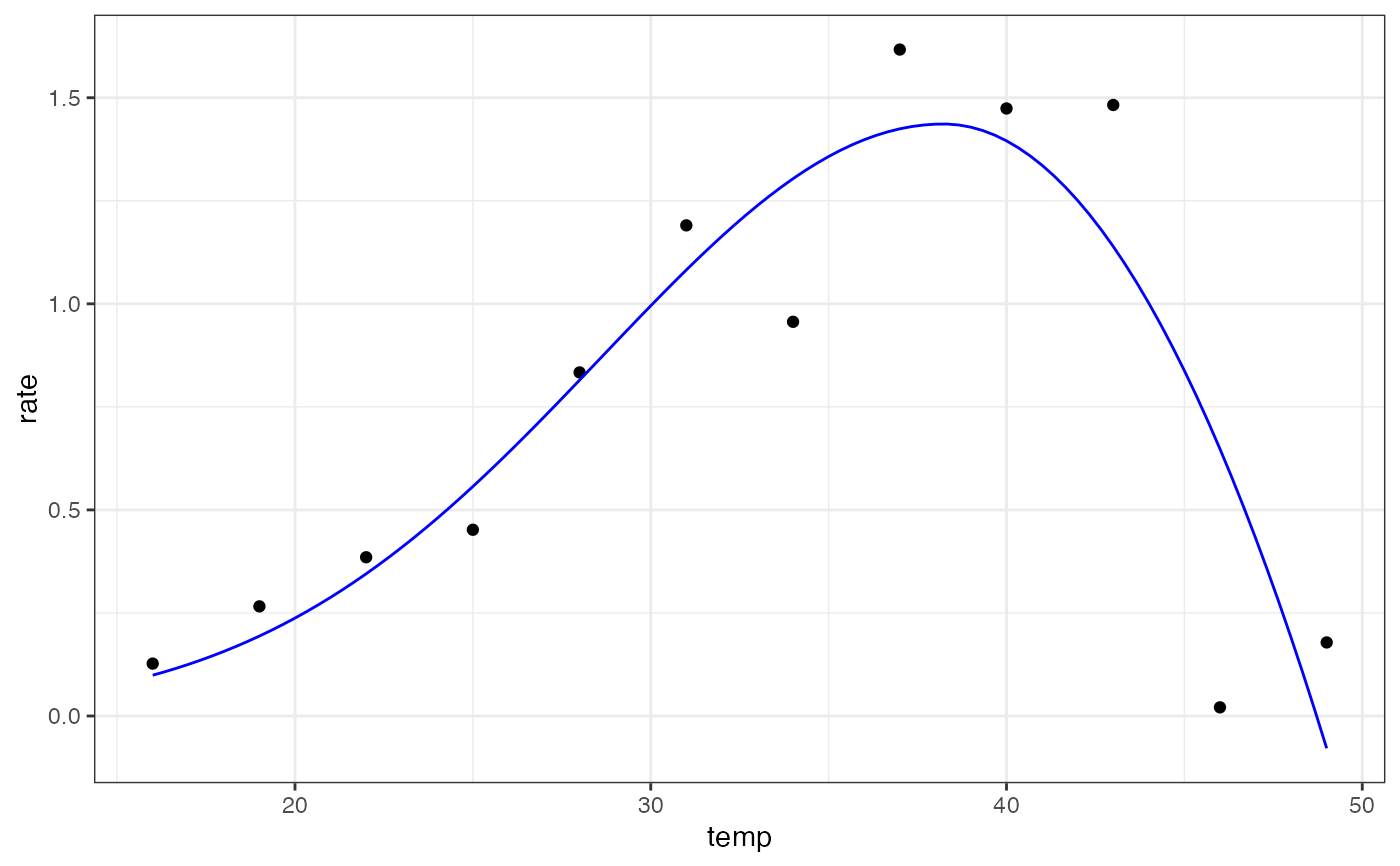
Modified deutsch model for fitting thermal performance curves
Source:R/deutsch_2008.R
deutsch_2008.RdModified deutsch model for fitting thermal performance curves
Value
a numeric vector of rate values based on the temperatures and parameter values provided to the function
Details
Equation: $$\textrm{if} \quad temp < t_{opt}: rate = r_{max} \cdot exp^{-\bigg(\frac{temp-t_{opt}}{2a}\bigg)^2}$$ $$\textrm{if} \quad temp > t_{opt}: rate = r_{max} \cdot \left(1 - \bigg(\frac{temp - t_{opt}}{t_{opt} - ct_{max}}\bigg)^2\right)$$
Start values in get_start_vals are derived from the data.
Limits in get_lower_lims and get_upper_lims are based on extreme values that are unlikely to occur in ecological settings.
References
Deutsch, C. A., Tewksbury, J. J., Huey, R. B., Sheldon, K. S., Ghalambor, C. K., Haak, D. C., & Martin, P. R. Impacts of climate warming on terrestrial ectotherms across latitude. Proceedings of the National Academy of Sciences, 105(18), 6668-6672. (2008)
Examples
# load in ggplot
library(ggplot2)
# subset for the first TPC curve
data('chlorella_tpc')
d <- subset(chlorella_tpc, curve_id == 1)
# get start values and fit model
start_vals <- get_start_vals(d$temp, d$rate, model_name = 'deutsch_2008')
# fit model
mod <- nls.multstart::nls_multstart(rate~deutsch_2008(temp = temp, rmax, topt, ctmax, a),
data = d,
iter = c(4,4,4,4),
start_lower = start_vals - 10,
start_upper = start_vals + 10,
lower = get_lower_lims(d$temp, d$rate, model_name = 'deutsch_2008'),
upper = get_upper_lims(d$temp, d$rate, model_name = 'deutsch_2008'),
supp_errors = 'Y',
convergence_count = FALSE)
# look at model fit
summary(mod)
#>
#> Formula: rate ~ deutsch_2008(temp = temp, rmax, topt, ctmax, a)
#>
#> Parameters:
#> Estimate Std. Error t value Pr(>|t|)
#> rmax 1.4363 0.1639 8.765 2.25e-05 ***
#> topt 38.2306 2.7887 13.709 7.73e-07 ***
#> ctmax 48.7175 0.9798 49.722 2.96e-11 ***
#> a 6.7950 1.9474 3.489 0.00821 **
#> ---
#> Signif. codes: 0 ‘***’ 0.001 ‘**’ 0.01 ‘*’ 0.05 ‘.’ 0.1 ‘ ’ 1
#>
#> Residual standard error: 0.3105 on 8 degrees of freedom
#>
#> Number of iterations to convergence: 34
#> Achieved convergence tolerance: 1.49e-08
#>
# get predictions
preds <- data.frame(temp = seq(min(d$temp), max(d$temp), length.out = 100))
preds <- broom::augment(mod, newdata = preds)
# plot
ggplot(preds) +
geom_point(aes(temp, rate), d) +
geom_line(aes(temp, .fitted), col = 'blue') +
theme_bw()
